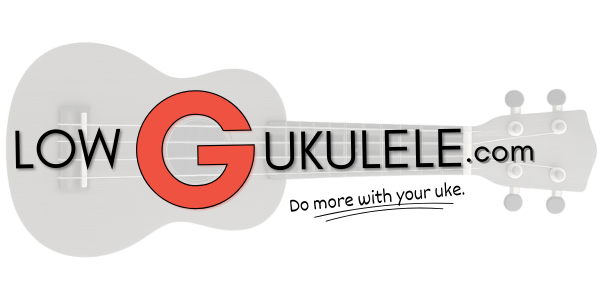This post is part of a series on how to read sheet music for ukulele in low G tuning. If you play uke in standard tuning, a lot of this won’t apply as your G-string is a full octave higher.
I provide TABs for all of the pieces I publish on LowGUkulele.com because I find it to be the easiest way for uke players of all ability levels to access new songs. That said, being able to read music is a really great skill to have in your back pocket, especially if you plan to progress from ukulele to other instruments.
You don’t need to worry about practicing this until you are an expert site-reader (someone who can play a new piece well the first time they play through it), but I do think it’s useful be able to at least take a piece of new sheet music and work your way through it, even if you need to use a cheat sheet. (Hint: There’s one at the bottom of this post.) You aren’t going to encounter much ukulele tablature in the wild.
To keep this post relatively short, I’m just covering the natural notes on the staff and where they fall on the neck of the uke. I’ll cover other sharps and flats and other notation (note duration/rhythm, time signatures, key signatures, etc.) in another post.
Let’s get started by learning the names of the lines and spaces on the staff.
The Notes of the Treble Clef
The entire range of the ukulele falls neatly on the treble clef (also known as the G-clef). I could write several paragraphs about the different clefs, how they relate, and why we use them, but that isn’t really necessary to learn at this point. Just know that if you see this symbol at the beginning of a piece of sheet music, you will be able to play it on ukulele:

The lines and spaces on the treble clef represent specific notes. Take a look at this chart, but don’t get overwhelmed. There are tricks to learning and remembering this.

The notes in the spaces are relatively easy to remember as they spell the word FACE from bottom to top. You can remember the notes on the lines either by going up or down one letter in the alphabet from an adjacent space, or you can use this mnemonic: Every Good Boy Does Fine.
Notes can extend above and below the staff as well, sitting either on or between short lines called “ledger lines” that are only included when they are needed. We’ll see an example of that in a minute. There’s no quick trick that I know of to memorize the notes of the ledger lines. You just have to learn to recognize them.
Finding the Open Strings
If you’re going to learn how to read only a little notation for ukulele, make it the open strings. They serve as landmarks on the staff, comfortable jumping-off points that allow you to figure out where you are and what else is nearby. If you need a refresher, the open strings of a ukulele in low G tuning are, from low to high, GCEA (Good Children Eat Asparagus).
Here’s what the open strings looks like on a staff alongside tablature:

You’ll notice that the two lower strings sit on ledger lines below the staff. You can figure out the names of the notes by moving backwards through the alphabet starting from the bottom line of the staff, which we already know is an E. If the bottom line is E, then the space below it must be D, and the line below that must be C, the second lowest open string on a low G ukulele.
Continuing down the ledger lines and backwards through the alphabet, the next space is B, followed by A on the second ledger line, and then looping back around G below the second ledger line, the lowest note on a low G ukulele.
The Notes in Between
Staying in first position (the first four frets of each string), we can fill in the spaces between the open strings.
On the G-string, you’ll find two notes – A on the 2nd fret; B on the 4th fret:

On the C-string, you’ll find only one additional note – D on the 2nd fret:

On the E-string, you’ll find two notes: F on the 1st fret; G on the 3rd fret:

On the A-string, you’ll find two notes: B on the 2nd fret; C on the 3rd fret:

Continuing Up The Neck
Many melodies require you to climb up out of first position on the A-string to access higher notes. Here’s a look at the notes up the 10th fret, taking us up to a high G, two octaves above the open G-string. Look back at the diagram from earlier if you can’t remember the names of the notes.

Cheat Sheet
I’ve put together a cheat sheet PDF with notes, tablature, and neck diagrams. Print it out and keep it nearby as a quick reference. The only way to get better at reading sheet music is to actually do it. Find some sheet music and start practicing (preferably in the key of C so you don’t have to worry about sharps and flats for now). It might be painfully slow at first, but you’ll be surprised how quickly you pick it up!
Click the download button below to get your copy of the cheat sheet PDF.
I’ll cover key signatures and sharps and flats next week. Happy picking!

Leave a Reply